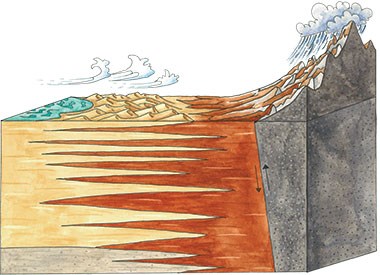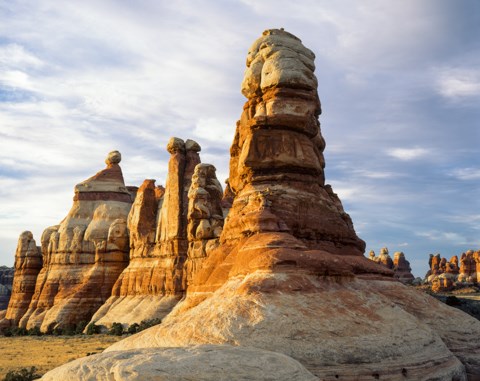Last updated: April 29, 2025
Article
Needles

NPS/Neal Herbert

NPS/Katrina Lund
In the southeast corner of Canyonlands, spires of Cedar Mesa Sandstone rise hundreds of feet above a network of canyons and grasslands know as "The Needles." Over 200 million years ago, this area was a dune field on the eastern edge of a shallow sea that stretched all the way to what is now California. Wind-blown sand formed the white bands in the Cedar Mesa Sandstone. Periodically, floods from mountains near present-day Grand Junction, Colorado, would inundate the sand with red sediment to create the red bands.
About 20 million years ago, long after these layers were deposited, movements in the Earth's crust caused the entire Canyonlands region to rise. This changed the local environment from one where sediment is deposited, to one in which it's eroded away. Water eats away at sandstone by attacking the cement holding the sand grains together. It acts even faster on areas of weakness such as fractures and cracks. Two events combined to cause extensive surface fractures in The Needles.

NPS/Neal Herbert
The Monument Uplift
The Monument Uplift is a "local" uplift that begins around the Needles and trends slightly southwest all the way to Monument Valley. This uplift caused the Cedar Mesa Sandstone around the Needles to crack as it bent upward, forming a series of fractures (called "joints" by geologists) trending from east to west.
The Paradox Formation
A thick layer of salt called the Paradox Formation is the second cause of fracturing in the Needles. Buried thousands of feet below the Cedar Mesa Sandstone, the salt is flowing slowly toward the Colorado River and dragging the overlying layers with it. As the surface layers stretch in a direction opposite the Monument Uplift, another series of fractures formed trending north to south.
At The Needles, these two opposing series of joints formed square blocks of rock. As water erodes the joints, these squares have been slowly sculpted into the magnificent pillars and spires that form The Needles district of Canyonlands.
